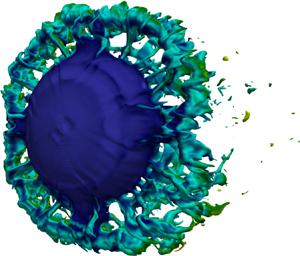Crossref Citations
This article has been cited by the following publications. This list is generated based on data provided by
Crossref.
Wang, Zhaoguang
Hopfes, Thomas
Giglmaier, Marcus
and
Adams, Nikolaus A.
2020.
Effect of Mach number on droplet aerobreakup in shear stripping regime.
Experiments in Fluids,
Vol. 61,
Issue. 9,
Trummler, Theresa
Bryngelson, Spencer H.
Schmidmayer, Kevin
Schmidt, Steffen J.
Colonius, Tim
and
Adams, Nikolaus A.
2020.
Near-surface dynamics of a gas bubble collapsing above a crevice.
Journal of Fluid Mechanics,
Vol. 899,
Issue. ,
Nykteri, Georgia
and
Gavaises, Manolis
2021.
Droplet aerobreakup under the shear-induced entrainment regime using a multiscale two-fluid approach.
Physical Review Fluids,
Vol. 6,
Issue. 8,
Obenauf, D. G.
and
Sojka, P. E.
2021.
Theoretical deformation modeling and drop size prediction in the multimode breakup regime.
Physics of Fluids,
Vol. 33,
Issue. 9,
Hasslberger, Josef
Ozel-Erol, Gulcan
Chakraborty, Nilanjan
Klein, Markus
and
Cant, Stewart
2021.
Physical effects of water droplets interacting with turbulent premixed flames: A Direct Numerical Simulation analysis.
Combustion and Flame,
Vol. 229,
Issue. ,
p.
111404.
Minko, Aleksandr
Guskov, Oleg
Arefyev, Konstantin
and
Saveliev, Andrey
2021.
Physical and Mathematical Modeling of the Interaction of Water Droplets and High-Speed Gas Flow.
Applied Sciences,
Vol. 11,
Issue. 23,
p.
11146.
Boyd, Bradley
and
Jarrahbashi, Dorrin
2021.
Numerical study of the transcritical shock-droplet interaction.
Physical Review Fluids,
Vol. 6,
Issue. 11,
Zhu, Wanli
Zhao, Ningbo
Jia, Xiongbin
Sun, Chengwen
and
Zheng, Hongtao
2021.
Effects of Airflow Velocity and Droplet Diameter on the Secondary Breakup Characteristics.
AIAA Journal,
p.
1.
Sharma, Shubham
Pratap Singh, Awanish
Srinivas Rao, S.
Kumar, Aloke
and
Basu, Saptarshi
2021.
Shock induced aerobreakup of a droplet.
Journal of Fluid Mechanics,
Vol. 929,
Issue. ,
Zhu, Wanli
Zhao, Ningbo
Jia, Xiongbin
Chen, Xiang
and
Zheng, Hongtao
2021.
Effect of airflow pressure on the droplet breakup in the shear breakup regime.
Physics of Fluids,
Vol. 33,
Issue. 5,
Biasiori-Poulanges, Luc
and
El-Rabii, Hazem
2021.
Shock-induced cavitation and wavefront analysis inside a water droplet.
Physics of Fluids,
Vol. 33,
Issue. 9,
Jackiw, Isaac M.
and
Ashgriz, Nasser
2021.
On aerodynamic droplet breakup.
Journal of Fluid Mechanics,
Vol. 913,
Issue. ,
Hopfes, T.
Wang, Z.
Giglmaier, M.
and
Adams, N. A.
2021.
Experimental investigation of droplet breakup of oxide-forming liquid metals.
Physics of Fluids,
Vol. 33,
Issue. 10,
Biasiori-Poulanges, Luc
Bokman, Guillaume T.
Baumann, Enea
and
Supponen, Outi
2022.
Dynamics of a shocked bubble-encapsulated droplet.
Applied Physics Letters,
Vol. 120,
Issue. 26,
Liu, Hai‐Feng
Wang, Yu‐Fan
Zhao, Hui
Li, Wei‐Feng
and
Xu, Jian‐Liang
2022.
Drop breakup and entrainment in the updraft.
AIChE Journal,
Vol. 68,
Issue. 8,
Panchal, Achyut
Bryngelson, Spencer H.
and
Menon, Suresh
2022.
A Seven-Equation Diffused Interface Method for Resolved Multiphase Flows.
SSRN Electronic Journal ,
Bian, Qingyong
Zhu, Chengxiang
Wang, Jingxin
Zhao, Ning
Zhao, Huanyu
and
Zhu, Chunling
2022.
Numerical investigation on the characteristics of single droplet deformation in the airflow at different temperatures.
Physics of Fluids,
Vol. 34,
Issue. 7,
Xu, Zhikun
Wang, Tianyou
and
Che, Zhizhao
2022.
Droplet breakup in airflow with strong shear effect.
Journal of Fluid Mechanics,
Vol. 941,
Issue. ,
Mansoor, M. M.
and
George, J.
2023.
Investigation of the Richtmyer–Meshkov instability using digital holography in the context of catastrophic aerobreakup.
Experiments in Fluids,
Vol. 64,
Issue. 2,
Sun, Shengxia
Chen, Fenghua
and
Zhao, Min
2023.
Numerical simulation and analysis of the underwater implosion of spherical hollow ceramic pressure hulls in 11000 m depth.
Journal of Ocean Engineering and Science,
Vol. 8,
Issue. 2,
p.
181.






